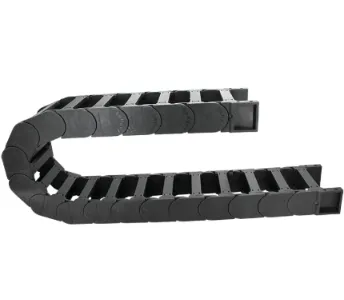Sustainable Materials for Flexible Cable Chains
In the dynamic landscape of industrial cable management, the quest for sustainable and high - performance solutions is ever - present. Nylon cable chain, flexible cable chain, and open cable chain have become indispensable for protecting and organizing cables in diverse machinery setups. Shijiazhuang Anjie Electric Co., Ltd. stands out in providing top - notch flexible cable chains crafted from sustainable materials, catering to the needs of wholesalers serving a wide range of industrial sectors.
Product Specifications of Nylon Cable Chain
|
Category |
Sīkāka informācija |
|
produkta nosaukums |
Pastiprināta neilona kabeļu ķēde |
|
Materiāls |
PA6, PA66 |
|
Krāsa |
Melns |
|
Standarta |
MINIMĀLAIS IZDOTS, LĪDZ TIEK ATBILDE |
|
Darba temperatūra |
- 40 - 130 °C |
|
Ieteicamā atstarpe |
10% |
|
Iespējas |
Wearable, elastic, fire proof, self - lubricating |
|
Atvērta puse |
Both side |
Material Advantages of Flexible Cable Chain
- Sustainable Nylon Composition:The flexible cable chain from Shijiazhuang Anjie Electric Co., Ltd. uses PA6 and PA66, which are not only durable but also have a relatively lower environmental impact compared to some less sustainable alternatives. These nylons can be recycled at the end of their service life, contributing to a circular economy in industrial operations.
- High - Performance Properties:PA6 and PA66 offer excellent mechanical strength, ensuring the nylon cable chain can withstand the rigors of continuous movement, heavy loads, and exposure to various industrial chemicals. Their inherent elasticity allows the chain to flex without damage, while the self - lubricating property reduces friction, enhancing the chain's lifespan and reducing maintenance needs.
- Fire - Proof and Wear - Resistant:The fire - proof feature of the flexible cable chain adds an extra layer of safety in industrial environments where fire hazards may exist. The wear - resistant nature ensures that even in high - abrasion applications, the chain maintains its integrity, reducing the frequency of replacements and minimizing waste.

Design and Flexibility of Open Cable Chain
- Open - Side Design Benefits: The open cable chainwith both - side open design from Shijiazhuang Anjie Electric Co., Ltd. allows for easy installation and maintenance of cables. Wholesalers can appreciate that this design simplifies the process of adding or removing cables, making it a convenient choice for various industrial setups.
- Flexibility in Application: The flexible nature of the flexible cable chainenables it to adapt to complex machinery movements. Whether it's in automated production lines, robotic systems, or CNC machines, the chain can bend and twist without kinking or damaging the cables inside. This flexibility ensures smooth operation of the machinery and reduces the risk of cable failures.
- Customization Potential:Given the diverse needs of industrial applications, Shijiazhuang Anjie Electric Co., Ltd. can leverage the design of the open cable chain to offer customization options. Wholesalers can work with the company to adjust parameters such as length, width, and open - side configurations to meet the specific requirements of their industrial clients.
Application Scenarios of Flexible Cable Chain
- Automotive Manufacturing: In automotive production lines, the nylon cable chainis used to manage cables for robotic welding systems, conveyor belts, and automated assembly equipment. Its flexibility and durability ensure that cables are protected during the constant movement and vibration in the manufacturing process.
- Food and Beverage Industry: The food - safe nature of the nylon materials (though not explicitly food - contact certified in a traditional sense but suitable for industrial environments) and the self - lubricating, wear - resistant features make the flexible cable chaina good choice for cable management in food processing plants. It can withstand cleaning agents and temperature variations in these facilities.
- Renewable Energy Sector: In wind turbines and solar power installations, the open cable chaincan be used to manage cables in the rotating and moving parts. Its ability to operate in a wide temperature range and resist wear makes it suitable for the harsh environmental conditions of these renewable energy projects.
Nylon Cable Chain FAQS
What are the key sustainability aspects of the nylon cable chain?
The nylon cable chain uses PA6 and PA66, which are recyclable materials, contributing to a more sustainable industrial cable management solution. Their long lifespan due to high - performance properties like wear resistance and self - lubrication also reduces the need for frequent replacements, minimizing waste generation.
How does the open - side design of the open cable chain benefit industrial operations?
The open - side design of the open cable chain allows for easy installation, inspection, and maintenance of cables. It simplifies the process of adding or removing cables, reducing downtime in industrial operations. This design also makes it easier to detect and address any cable issues promptly.
Can the flexible cable chain be used in high - temperature industrial environments?
Yes, the flexible cable chain has a working temperature range of - 40 - 130 °C, making it suitable for use in high - temperature industrial environments such as foundries and some manufacturing processes where elevated temperatures are present.
What industrial standards does the nylon cable chain comply with?
The nylon cable chain complies with a variety of international standards including DIN, GB, ISO, JIS, BA, and ANSI. This wide - ranging compliance ensures that it can be used in diverse industrial projects across different regions without facing standard - related barriers.
How does the self - lubricating feature of the flexible cable chain enhance its performance?
The self - lubricating feature of the flexible cable chain reduces friction between the chain links and the cables inside. This not only extends the lifespan of the chain and the cables but also ensures smoother operation of the machinery, reducing energy consumption and maintenance requirements.








